Monthly Archives: November 2021
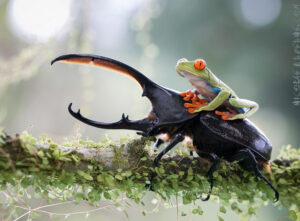 The Alaskan Wood Frog is a unique amphibian, and not one I would probably be interested in, but this one is special. It’s not just that they live in Alaska, where it gets quite cold part of the year, and it’s not their strange looks…long skinny legs, orange eyes, or orange toes. Strange looking as that is, in the wild it is not that unusual. The unusual thing about these frogs is that they have a high tolerance to subzero temperatures. In fact, that cold tolerance is so strong that when winter sets in, the Alaskan Tree Frog begins to freeze. It doesn’t burrow underground, or migrate to the south, or any other evasive action, it just freezes in place, and in the position that it is in, as it freezes.
The Alaskan Wood Frog is a unique amphibian, and not one I would probably be interested in, but this one is special. It’s not just that they live in Alaska, where it gets quite cold part of the year, and it’s not their strange looks…long skinny legs, orange eyes, or orange toes. Strange looking as that is, in the wild it is not that unusual. The unusual thing about these frogs is that they have a high tolerance to subzero temperatures. In fact, that cold tolerance is so strong that when winter sets in, the Alaskan Tree Frog begins to freeze. It doesn’t burrow underground, or migrate to the south, or any other evasive action, it just freezes in place, and in the position that it is in, as it freezes.
As the Alaskan Wood Frog freezes, little ice crystals form all over its body, and it begins to look like a frog snowman…or iceman. The frog’s heart stops and blood no longer flows. All of its organs are frozen. I suppose I have basically just described the death of the Alaskan Wood Frog, but I have not. This tiny amphibian can survive being almost completely frozen during winter, only to miraculously come back to life as soon as spring arrives!
It is a type of hibernation, I suppose. It isn’t the kind of warm, cozy, sleep-off-the-fat type of hibernation that bears go through. For days, even weeks at a time during its period of winter hibernation, over 60 percent of the frog’s body freezes. The frog stops breathing and its heart stops beating. All of its physical processes, such as 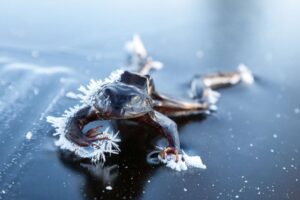 metabolic activity and waste production come to a halt. “For all intents and purposes, they are dead,” said Don Larson, a Ph.D. student at Fairbanks, Alaska. As per his research, wood frogs can survive long winters where temperatures ranging between -48 Celsius to -64 Celsius. In fact, it can go through 10 to 15 freeze/thaw cycles over the course of a single season.
metabolic activity and waste production come to a halt. “For all intents and purposes, they are dead,” said Don Larson, a Ph.D. student at Fairbanks, Alaska. As per his research, wood frogs can survive long winters where temperatures ranging between -48 Celsius to -64 Celsius. In fact, it can go through 10 to 15 freeze/thaw cycles over the course of a single season.
As researchers have studied the amazing Alaskan Wood Frog, they have discovered the reason that the frog can survive such an extreme hibernation cycle. They have discovered that the reason for this the miraculous phenomenon is the high concentration of cryoprotectants in the wood frog’s tissues. What are cryoprotectants, you might ask. I wondered too. Cryoprotectants are “solutes – including glucose and urea.” They lower the freezing temperature of the frog’s cells, helping them survive. Exposure to subzero temperatures for a long time could cause cellular shrinkage in most animals. During the freezing process, water is pulled from the body’s cells to form ice, eventually sucking them dry and killing the cell. Cryoprotectants help the cells resist shrinkage in the wood frog, basically saving their lives. “The solutes tend to depress the freezing point. It limits the amount of ice that actually forms in the body at any part,” said Jon Costanzo of the Department of Zoology at Miami University in Ohio, who has been researching wood frogs for the past 25 years.
The research done into the Alaskan Wood Frog has helped medical researchers to discover ways that living  organs and tissues can be frozen and unfrozen without damaging them. That could be an amazing step forward in the area of organ transplants. Costanzo explained, “There’s an obvious parallel between what these frogs are doing to preserve all of their tissues simultaneously and our need to be able to cryopreserve human organs for tissue-matching purposes. If you could freeze human organs even for a short period of time, that would be a major breakthrough because then these organs could be shipped around the world, which would greatly [improve] the donor-matching process.” It amazing that the seemingly insignificant study of a frozen Alaskan Wood Frog could have such a great impact on the medical world of humans.
organs and tissues can be frozen and unfrozen without damaging them. That could be an amazing step forward in the area of organ transplants. Costanzo explained, “There’s an obvious parallel between what these frogs are doing to preserve all of their tissues simultaneously and our need to be able to cryopreserve human organs for tissue-matching purposes. If you could freeze human organs even for a short period of time, that would be a major breakthrough because then these organs could be shipped around the world, which would greatly [improve] the donor-matching process.” It amazing that the seemingly insignificant study of a frozen Alaskan Wood Frog could have such a great impact on the medical world of humans.
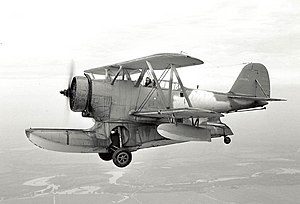 “Leave No Man Behind” is a creed often repeated and strictly followed by various units and soldiers. The interpretation of the phrase is applied to the treatment and extraction of the seriously wounded, the recovery of the body of military members killed in action, and the attempts to rescue or trade for prisoners of war. Technically, it didn’t really apply concerning the North Atlantic Ferry Route, also known as the Snowball Route. The route was a transport route used during World War II. It went from Goose Bay, Labrador to the one-way runway at Bluie West One on Greenland. Then, the route continued across to Keflavik, Iceland, for a refueling stop. From there it continued to Prestwick, Scotland and finally to England. The route was the United Kingdom’s World War II aerial lifeline, and was used by freighters, as well as European Theater of Operations-bound bombers and fighters…which means that my dad, Staff Sergeant Allen Lewis Spencer might have traveled this route on his way to Great Ashfield Army Airforce Base, Suffolk, England, where he was stationed during World War II.
“Leave No Man Behind” is a creed often repeated and strictly followed by various units and soldiers. The interpretation of the phrase is applied to the treatment and extraction of the seriously wounded, the recovery of the body of military members killed in action, and the attempts to rescue or trade for prisoners of war. Technically, it didn’t really apply concerning the North Atlantic Ferry Route, also known as the Snowball Route. The route was a transport route used during World War II. It went from Goose Bay, Labrador to the one-way runway at Bluie West One on Greenland. Then, the route continued across to Keflavik, Iceland, for a refueling stop. From there it continued to Prestwick, Scotland and finally to England. The route was the United Kingdom’s World War II aerial lifeline, and was used by freighters, as well as European Theater of Operations-bound bombers and fighters…which means that my dad, Staff Sergeant Allen Lewis Spencer might have traveled this route on his way to Great Ashfield Army Airforce Base, Suffolk, England, where he was stationed during World War II.
I don’t imagine that landings at Bluie West One on Greenland would be easy on the best of days, and if the weather was bad, it was going to be far worse, and if there was any airplane trouble, it was really going to get dicey. On November 5, 1942, a Douglas C-53 Skytrooper, a paratroop-outfitted version of the C-47, was heading westbound on the Snowball Route. The plane was empty except for its crew of two and three military passengers returning to the United States from Scotland. The Skytrooper never made it. The crew radioed that they had to make a forced landing on the Greenland ice cap and giving an approximate position. The airplane was intact, and apparently there were no injuries.
Now began the hardest part of the situation…rescue. The C-53 fired flares for the next two nights. The flares were seen at a weather station on the Greenland coast, and rescuers set out toward them on motorized sleds. The group expected to be back in three or four days, if the weather held, but their sleds broke down, and they never found the C-53. After that, the flares stopped, and the plane and crew would never be seen or heard of again. Meanwhile, a variety of eastbound B-17s, B-25s, and C-47s that were either already over Greenland or gassing up at Narsarsuaq, the famous Bluie West One base, were detoured for search duty. One of them was a B-17F originally bound for England. On November 9 it took off from Bluie West One, assigned to search the area where the C-53’s flares had last been seen. Aboard the Flying Fortress were its original six-man transport crew, an Army enlisted man they had picked up at Goose Bay and two volunteer observers who had jumped aboard at Bluie West One to help out…an offer they would no doubt regret. 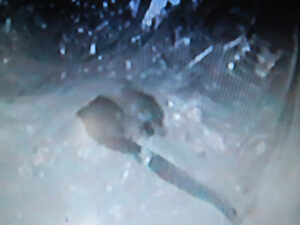
Just as the B-17 reached its search area, it ran into bad weather. Following pilot, Lieutenant Armand Monteverde’s 180 around the weather, he headed back into the search grid, only to fly into a sudden whiteout. Suddenly, the sky, clouds, and ice all looked the same. It was as if the horizon disappeared. Monteverde had no choice but did the only thing he could and banked away to fly back to clearer air. But the B-17’s left wingtip caught the ground, and the airplane skidded onto the ice cap. It was a hard crash, with the bomber traveling only about 200 yards before splitting apart just behind the wings. The Fortress had come down atop an active glacier, spider-webbed with crevasses. It was like landing in the middle of a minefield. The entire broken-off tail section hung over a large open chasm, with another chasm yawning just in front of the bomber. One crewman suffered a broken arm, and others had bad cuts and bruises. Just four were unhurt.
Meanwhile, an RAF Douglas Havoc out of Gander, being ferried through a snowstorm by a Canadian crew, flew past its refueling stop at Narsarsuaq and put down on the ice before its tanks ran totally dry. The Canadians set out on foot for the coast. On November 18, a search plane out of BW-1 spotted the Havoc, but its crew was gone. Five days later, a Grumman J2F-4 Duck from the Coast Guard cutter Northland, landed on the southeast coast of Greenland. They found the crew’s trail, and followed their snowshoe tracks. The men had actually fabricated snowshoes from pieces stripped from the Havoc. That night, Northland fired off flares, and the Havoc crew spotted them. The in an act much like burning his bridges, one of the pilots responded by setting fire to his coat, which in Greenland in late November is a good way to freeze to death. Fortunately, the blazing parka was spotted by crewman aboard Northland, which put a rescue party ashore and found the Havoc crew.
On the morning of November 28, the cutter Northland dispatched their Grumman J2F-4, a plane known as the Duck into the hunt as well. On board were Coast Guard pilot Lieutenant John Pritchard Jr and his radioman, Petty Officer 1st Class Benjamin Bottoms. They took off for the B-17 crash site. Pritchard overflew the B-17 and radioed its crew for landing advice. “Don’t try it,” Corporal Howarth replied, “crevasses everywhere.” Colonel Balchen, coincidentally, was overhead at that moment in the DC-4, making a supply drop. Nevertheless, Pritchard found a smooth, sloped, apparently crevasse-free area a mile north of the B-17 and carefully touched down with his landing gear extended. He landed uphill, and the Duck quickly came to a stop. It was the very first successful landing of an airplane on the surface of Greenland’s ice cap. The Duck made two trips to rescue 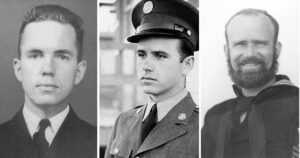 the men in the B-17, the first successful; and the second with passenger, radioman Loren Howarth, ended in a crash that would leave the plane lost for seven decades.
the men in the B-17, the first successful; and the second with passenger, radioman Loren Howarth, ended in a crash that would leave the plane lost for seven decades.
Fast forward…to 2012, when a company by the name Global Exploration and Recovery found the remains of the Duck in 38 feet of ice, with its crew and passenger still onboard. GEaR believes in “Leave No Man Behind,” and does its best to find these downed war birds to bring them and their crew…finally home, if they are still in the planes. What a noble effort.

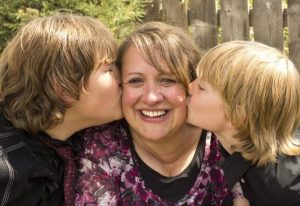 My niece, Machelle Moore has been looking at a different kind of future these days. As a mom, I know that the years of her children’s childhood have flown past with unbelievable speed. Her eldest son, Weston moved to Butte, Montana from their home in Powell, Wyoming this past year, and while that isn’t a cross country move, it does leave Machelle’s home with three people instead of four. Now, her youngest son, Easton is going to be graduating from high school, and the inevitable time when he will also leave home is just around the corner. Easton hasn’t specifically made plans to move out or away, but Weston hadn’t either…until he did. Most parents will face the empty nest moment at some point in their life, and it is not an easy one.
My niece, Machelle Moore has been looking at a different kind of future these days. As a mom, I know that the years of her children’s childhood have flown past with unbelievable speed. Her eldest son, Weston moved to Butte, Montana from their home in Powell, Wyoming this past year, and while that isn’t a cross country move, it does leave Machelle’s home with three people instead of four. Now, her youngest son, Easton is going to be graduating from high school, and the inevitable time when he will also leave home is just around the corner. Easton hasn’t specifically made plans to move out or away, but Weston hadn’t either…until he did. Most parents will face the empty nest moment at some point in their life, and it is not an easy one.
Machelle and her husband, Steve have been happily married since August 14, 1999, but when their boys are both out of the house, that inevitable feeling of a “too quiet house” will creep in. They will have to learn to find new hobbies, new activities, and new ways to spend their evenings. The good news is that Machelle and Steve have a great marriage. They love to do lots of things together, like camping, hiking and exploring, and their favorite…rock hunting. I know that like every “empty nester” among us has found, life does go on and it’s even good, whether our children live at home or not. And eventually, the grandchildren start to come, and the home is filled with new life. You never know whan that will start, however, so Machelle and Steve will have lots of good times in the meantime.
For now, Machell and Steve are busy with all the senior year activities that Easton has going on, like prom and Easton’s dating and working life. There are lots of exciting things happening during a kid’s senior year, like senior pictures, and soon graduation planning and rehearsals. The only problem with all that activity is that it 
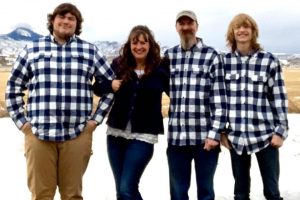 only serves to make the year go by faster…rather defeating the whole idea of “putting the brakes” on the year. Well, as we all know, it just doesn’t work that way. Nevertheless, Machelle and Steve will survive the empty nest, whenever it arrives, just like the rest of the parents in the world have done. For now, I pray the time slows down just a bit before that fateful day arrives. Today is Machelle’s birthday. Happy birthday Machelle!! Have a great day!! We love you!!
only serves to make the year go by faster…rather defeating the whole idea of “putting the brakes” on the year. Well, as we all know, it just doesn’t work that way. Nevertheless, Machelle and Steve will survive the empty nest, whenever it arrives, just like the rest of the parents in the world have done. For now, I pray the time slows down just a bit before that fateful day arrives. Today is Machelle’s birthday. Happy birthday Machelle!! Have a great day!! We love you!!
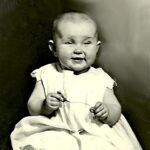
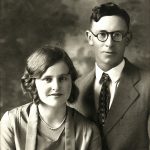 For a while now, in my Bible study, I have been studying about Jesus as the good shepherd. While that may not really remind most people in our family of my husband’s grandpa, Robert Knox, it does remind me of him. Jesus’ stories about how a good shepherd would do what it takes to keep his flock of sheep safe, are really true of any “good” shepherd. The whole job of a shepherd is to fight off the coyote, mountain lion, bear, or any other predator that might harm or even kill the sheep. In Biblical times, and maybe even to this day, the shepherd is often the only one with the sheep, because as we all know, sheep are a fairly docile animal. Predators…however, are definitely not docile. They are ravenously hungry, and you, the shepherd, are the only thing that lies between them and their next meal. That puts you, the shepherd…in the way.
For a while now, in my Bible study, I have been studying about Jesus as the good shepherd. While that may not really remind most people in our family of my husband’s grandpa, Robert Knox, it does remind me of him. Jesus’ stories about how a good shepherd would do what it takes to keep his flock of sheep safe, are really true of any “good” shepherd. The whole job of a shepherd is to fight off the coyote, mountain lion, bear, or any other predator that might harm or even kill the sheep. In Biblical times, and maybe even to this day, the shepherd is often the only one with the sheep, because as we all know, sheep are a fairly docile animal. Predators…however, are definitely not docile. They are ravenously hungry, and you, the shepherd, are the only thing that lies between them and their next meal. That puts you, the shepherd…in the way.
At this point, you might be wondering how that applies to Grandpa Knox, but it does. Grandpa was a shepherd for a time in his working days, and he had an even bigger reason to keep predators away from his flock. While many shepherds were along with their flock, Grandpa was not. He had his wife, Nettie and their three-year-old daughter, Joann Knox (Schulenberg) with him, and it was his most important job to keep them safe. I can’t say that he ever wrestled a coyote, mountain lion, or bear, but it’s possible that he had to kill a few with a gun.
Grandpa Knox did not really seem the type to be a mighty hunter or killer of predators, but I suppose he would 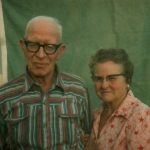
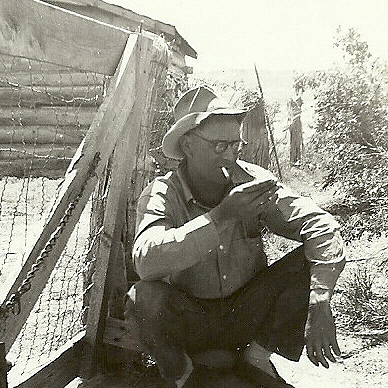 have had to become that in the event of a situation. The Grandpa Knox I met when I joined this family was more the gardener type. Grandpa spent much of his summer hours tending the garden on my in-laws place that provided our family with lots of great vegetables. I thought that the biggest predator Grandpa handled was a stray cow or maybe a hungry bunny rabbit. I suppose he did handle those too, but once upon a time, he protected the sheep in his flock, just like the stories Jesus told us about the shepherd and the predator. Today is the 113th anniversary of Grandpa Knox’s birth. Happy birthday in Heaven, Grandpa Knox!! We love and miss you very much!!
have had to become that in the event of a situation. The Grandpa Knox I met when I joined this family was more the gardener type. Grandpa spent much of his summer hours tending the garden on my in-laws place that provided our family with lots of great vegetables. I thought that the biggest predator Grandpa handled was a stray cow or maybe a hungry bunny rabbit. I suppose he did handle those too, but once upon a time, he protected the sheep in his flock, just like the stories Jesus told us about the shepherd and the predator. Today is the 113th anniversary of Grandpa Knox’s birth. Happy birthday in Heaven, Grandpa Knox!! We love and miss you very much!!
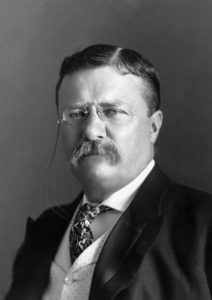
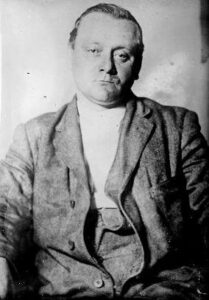 I have always known that I was stubborn, and “bull headed” and if you ask my sisters, they will very much agree with me on that fact, but I seriously doubt if they would ever call me stubborn if I were compared to President Theodore Roosevelt. I don’t think many people are as stubborn as Roosevelt was. Roosevelt didn’t run for his initial term in office, but rather became president of the United States because William McKinley was assassinated while Roosevelt was serving as vice president. He did run for and win a second term in the election of 1904, during which he promised not to run for a third term thereafter. A man of his word to a point, Roosevelt stuck to that promise through the 1908 election, but then he decided to run for President again in 1912, first losing the Republican primary to the incumbent William Taft and then running at the head of a brand-new party, the Progressive “Bull Moose” Party. It is a strange name for a political party, but I think it might have been appropriate for Roosevelt.
I have always known that I was stubborn, and “bull headed” and if you ask my sisters, they will very much agree with me on that fact, but I seriously doubt if they would ever call me stubborn if I were compared to President Theodore Roosevelt. I don’t think many people are as stubborn as Roosevelt was. Roosevelt didn’t run for his initial term in office, but rather became president of the United States because William McKinley was assassinated while Roosevelt was serving as vice president. He did run for and win a second term in the election of 1904, during which he promised not to run for a third term thereafter. A man of his word to a point, Roosevelt stuck to that promise through the 1908 election, but then he decided to run for President again in 1912, first losing the Republican primary to the incumbent William Taft and then running at the head of a brand-new party, the Progressive “Bull Moose” Party. It is a strange name for a political party, but I think it might have been appropriate for Roosevelt.
When Roosevelt decided to run for president again in 1912, a saloon owner named John Schrank became obsessed with him, and after having a nightmare that convinced Schrank that Roosevelt was responsible for McKinley’s assassination. That fueled his obsession, and on October 14, 1912, he walked up to Roosevelt as he exited a Milwaukee hotel on route to a campaign event and fired a .38-caliber revolver right into his chest. For most people, this would be the end of the story, but this is where Roosevelt really earned the name attached to the political party of which he was a member.
Unfortunately, Schrank was not a bad shot, and the bullet hit its mark. Fortunately, the path of the bullet was not an easy one. After passing through Roosevelt’s glasses case and 50 pages worth of notes in his breast pocket, which slowed it down considerably the bullet hit Roosevelt’s chest. The items in its way likely slowed the bullet enough to save Roosevelt’s life. Then, in typical “bull headed” fashion, the former president coughed into his hands to check for blood, and upon finding none, continued on to the Milwaukee Auditorium, where he delivered an 84-minute speech that began with the following lines, “Friends, I shall ask you to be as quiet as possible. I don’t know whether you fully understand that I have just been shot; but it takes more than that to kill a Bull Moose. But fortunately, I had my manuscript, so you see I was going to make a long speech, and there is a bullet – there is where the bullet went through – and it probably saved me from it going into my heart. The bullet is in me now, so that I cannot make a very long speech, but I will try my best.”
The bullet stayed lodged in his ribs throughout the rest of his unsuccessful campaign, and until his passing in 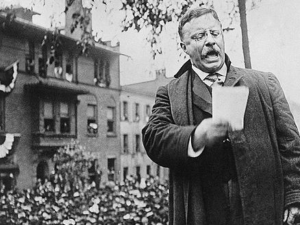
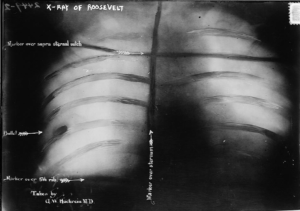 1919. While Roosevelt lost his race, his determination did show the kind of fortitude it takes to be president of this country. Being the leader of the free world, is not something that can be handled easily. The President of the United States must be an anointed position, and it is not one that just anyone can handle. In many ways, the best presidents are a type of “bull moose.” They have to be to take the pounding they have to take, and then keep coming back for more.
1919. While Roosevelt lost his race, his determination did show the kind of fortitude it takes to be president of this country. Being the leader of the free world, is not something that can be handled easily. The President of the United States must be an anointed position, and it is not one that just anyone can handle. In many ways, the best presidents are a type of “bull moose.” They have to be to take the pounding they have to take, and then keep coming back for more.
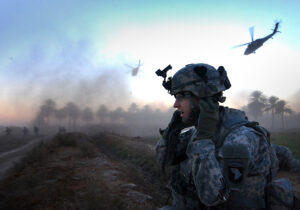 When the United States Army sends in the Army Special Forces, they are sending their very best people. It’s not that all of our soldiers aren’t the best in the world, because they are, but the Special Forces, also known as the “Green Berets” due to their distinctive service headgear, are a special operations force of the United States Army that are “designed to deploy and execute nine doctrinal missions: unconventional warfare, foreign internal defense, direct action, counter-insurgency, special reconnaissance, counter-terrorism, information operations, counterproliferation of weapons of mass destruction, and security force assistance. The first two missions, unconventional warfare and foreign internal defenses, emphasize language, cultural, and training skills in working with foreign troops. Other Special Forces missions, known as secondary missions, include: combat search and rescue (CSAR), counter-narcotics, hostage rescue, humanitarian assistance, humanitarian demining, information operations, peacekeeping, and manhunts.” Normally, the Special Forces teams are the ones sent in to rescue the other
When the United States Army sends in the Army Special Forces, they are sending their very best people. It’s not that all of our soldiers aren’t the best in the world, because they are, but the Special Forces, also known as the “Green Berets” due to their distinctive service headgear, are a special operations force of the United States Army that are “designed to deploy and execute nine doctrinal missions: unconventional warfare, foreign internal defense, direct action, counter-insurgency, special reconnaissance, counter-terrorism, information operations, counterproliferation of weapons of mass destruction, and security force assistance. The first two missions, unconventional warfare and foreign internal defenses, emphasize language, cultural, and training skills in working with foreign troops. Other Special Forces missions, known as secondary missions, include: combat search and rescue (CSAR), counter-narcotics, hostage rescue, humanitarian assistance, humanitarian demining, information operations, peacekeeping, and manhunts.” Normally, the Special Forces teams are the ones sent in to rescue the other 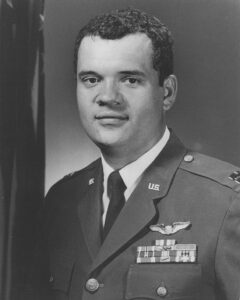 soldiers, or at least to drag them out of a sticky situation, but on this occasion, it was the Special Forces team that needed to be rescued.
soldiers, or at least to drag them out of a sticky situation, but on this occasion, it was the Special Forces team that needed to be rescued.
While returning to base from another mission, Air Force 1st Lieutenant James P Fleming and four other Bell UH-1F helicopter pilots received an urgent message from an Army Special Forces team. The pilots were told that the team was pinned down by enemy fire. Several of the other helicopter pilots had to leave the area because they were low on fuel, but Lieutenant Fleming and another pilot pressed on with the rescue effort. While the first attempt failed because of intense ground fire, they refused to abandon the Army green berets. Then, Fleming managed to land and pick up the team. Against all odds, he safely arrived at his base near Duc Co, at which time it was discovered that his helicopter was nearly out of fuel. For his lifesaving efforts, Lieutenant Fleming was later awarded the Medal of Honor for his actions. It was a selfless act, that could have cost him his life, but Lieutenant Fleming didn’t even consider his own life. He only thought about the others.
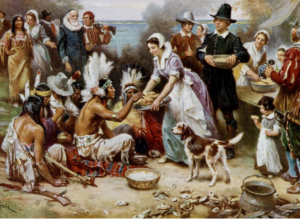 The past almost two years have been tough for everyone. Many of us have had to forgo this holiday or that holiday, because on or more family members have contracted Covid-19, and had to be quarantined. Nevertheless, more and more people are surviving Covid, and that is definitely something to be thankful for. In fact, as I contemplate Thanksgiving I find that I feel the need to look for things to be thankful for, rather than complaining about how hard things have been. That reminds me of the first Thanksgiving.
The past almost two years have been tough for everyone. Many of us have had to forgo this holiday or that holiday, because on or more family members have contracted Covid-19, and had to be quarantined. Nevertheless, more and more people are surviving Covid, and that is definitely something to be thankful for. In fact, as I contemplate Thanksgiving I find that I feel the need to look for things to be thankful for, rather than complaining about how hard things have been. That reminds me of the first Thanksgiving.
Most of us picture a big party were the new neighbors, the Pilgrims and the Wampanoag Indian Tribe, came together to celebrate newfound friendships, but that wasn’t it at all. Many in the Wampanoag tribe, as well as the entire Patuxet Tribe, had died of smallpox. To make matters worse, the Pilgrims were in danger of starving to death.  They really didn’t know much about farming, and between the smallpox, the winter cold, and lack of food, the Pilgrims were in a lot of trouble. With the help of the Wampanoag Tribe, the things they had to be thankful for, were many and they really were.
They really didn’t know much about farming, and between the smallpox, the winter cold, and lack of food, the Pilgrims were in a lot of trouble. With the help of the Wampanoag Tribe, the things they had to be thankful for, were many and they really were.
This past year reminds me quite a bit of the situation the Pilgrims and the Indians were in when they pulled together, helped each other, and in the end came through with much to celebrate and much to be thankful for. We have a long way to go, because much is broken right now, but the people of this nation are starting to fight for the the freedoms we have always known and loved, and we are thankful for every victory we see, and they are coming each day. Like the Pilgrims and the Indians, we have a long way to go, and many battles along the way, but we are a persevering people, and we will be great again. I am so thankful for all the people who are 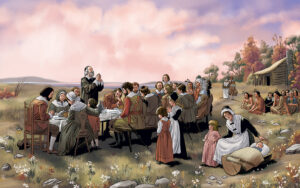 willing to step in and fight for this country, for life, liberty, and the pursuit of happiness. With people like this and above all, our awesome God leading the battle, we can’t lose.
willing to step in and fight for this country, for life, liberty, and the pursuit of happiness. With people like this and above all, our awesome God leading the battle, we can’t lose.
We have come through the times of illness, loss, and trial. Now we, as a nation, need to begin to pick ourselves up by our boot straps and prove to ourselves exactly what we are made of. I have no doubt in my mind that we can do this, and by Thanksgiving of 2022, we will be totally amazed at who we are, how far we have come, and we will have so many more things to be thankful for. Happy Thanksgiving everyone!! Have a great holiday!!
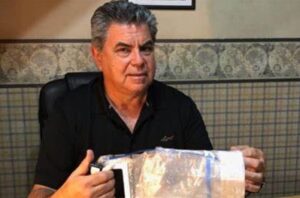 What can a car mechanic possibly have to do with the medical field? To me, they seem to be two very different fields, but when Jorge Odon came on the scene, all that changed. Jorge Odon is an Argentinian auto mechanic and inventor who created a device that has already been used hundreds of times, to assist in difficult births that could prove to be fatal for child and mother. It is appropriately named The Odon Device, and it is an “extremely simple tool that involves a plastic bag being inserted into the uterus and blown up with air, this then grips the baby’s head and allows it to be removed quickly and relatively painlessly.” The whole process seems like it could kill the baby, but in reality, it only looks dangerous.
What can a car mechanic possibly have to do with the medical field? To me, they seem to be two very different fields, but when Jorge Odon came on the scene, all that changed. Jorge Odon is an Argentinian auto mechanic and inventor who created a device that has already been used hundreds of times, to assist in difficult births that could prove to be fatal for child and mother. It is appropriately named The Odon Device, and it is an “extremely simple tool that involves a plastic bag being inserted into the uterus and blown up with air, this then grips the baby’s head and allows it to be removed quickly and relatively painlessly.” The whole process seems like it could kill the baby, but in reality, it only looks dangerous.
To ensure that the device does not damage the lining of the uterus, the bag only goes over the head of the baby so that the volume of material going into the uterus is limited. Meanwhile, there is little chance for the baby to be injured. Babies in the womb do not breath and therefore, the bag cannot suffocate them and it is far safer than other methods. Forceps and Ventouse devices (a vacuum extractor for use in assisting childbirth) can damage tissue and cause injuries to the skull of the infant. The idea for this lifesaving device first came to Odon in 2006 after seeing a video hack on how to remove a loose cork from an empty wine bottle. Seriously!! I find it totally amazing that someone can look at something like a cork in a bottle, and in their mind, see a 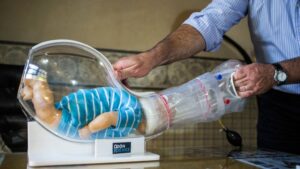 totally different, yet similar way to used the idea for the removal of the cork. The Odon Device is making a splash nevertheless. It has caught the attention of the world health organization (WHO) and global medical technology company, BD, which is currently developing the product. The device is incredibly inexpensive and easy to use, and so it is thought to be perfect for use in developing countries. It seems that in these In these types of countries, birth difficulties can often be fatal and so this tool has the potential to save an incredible amount of lives in the future. I think it is an incredible device for any country. Forceps have long been a dangerous device for babies, and the Ventouse Device sounds absolutely barbaric.
totally different, yet similar way to used the idea for the removal of the cork. The Odon Device is making a splash nevertheless. It has caught the attention of the world health organization (WHO) and global medical technology company, BD, which is currently developing the product. The device is incredibly inexpensive and easy to use, and so it is thought to be perfect for use in developing countries. It seems that in these In these types of countries, birth difficulties can often be fatal and so this tool has the potential to save an incredible amount of lives in the future. I think it is an incredible device for any country. Forceps have long been a dangerous device for babies, and the Ventouse Device sounds absolutely barbaric.
 During World War II, the Nazis had a little problem…the resistance. Of course, the resistance had to be very careful, and stay in hiding much of the time. There were informants, the police, and the enemy soldiers to watch out for. It was hard to tell sometimes who was an enemy and who was a friend. Every day was spent in hiding, and often in fear for their lives.
During World War II, the Nazis had a little problem…the resistance. Of course, the resistance had to be very careful, and stay in hiding much of the time. There were informants, the police, and the enemy soldiers to watch out for. It was hard to tell sometimes who was an enemy and who was a friend. Every day was spent in hiding, and often in fear for their lives.
With the Allied invasion of Normandy, the French resistance saw an opportunity to really increase their activity in the area. Of course, there were more fighter pilots in need of an escape routes, and soldiers who were wounded, but they also saw a way to strike back. One such way was to kidnap and kill Helmut Kampfe, a major in the Waffen-SS Das Reich. Of course, all resistance action came at a cost. Following the killing of Kampfe, a battalion of the regiment known 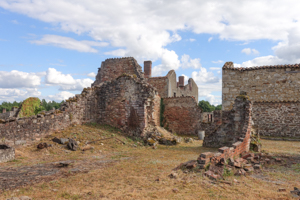 as Der Fuhrer Regiment was sent to the small village of Oradour-sur-Glane.
as Der Fuhrer Regiment was sent to the small village of Oradour-sur-Glane.
Of course, the village was innocent, but someone had to pay so Commander Adolf Diekmann ordered the town sealed off, the men locked in barns, and the women and children confined to the church. Nobody knows why the town was chosen for this attack. Maybe it was due to the town’s proximity to the regiment, or maybe it was because the Germans knew the village was defenseless. Whatever it was, it was about to get brutal.
Diekmann ordered his unit to begin shooting. It was like a terrorist attack. The residents were first incapacitated by gunshots to the legs. When they 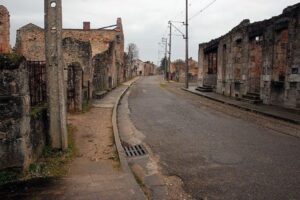 were unable to move, the barns and church were doused with gasoline and ignited. Hundreds of the villagers died that day, nearly all the residents of the area. Many of the SS who were there that day were Alsatian French nationals who had been forced into the German military, and almost all them escaped punishment, which is a crime in itself. After World War II, French president Charles De Gaulle declared that the village was never to be restored. It was to stand as it was after the attack, as a reminder of the brutal Nazi occupation. Brutality like that should never be forgotten, and maybe the evidence should stand as a reminder of the evil that exists in some people. Lest we forget.
were unable to move, the barns and church were doused with gasoline and ignited. Hundreds of the villagers died that day, nearly all the residents of the area. Many of the SS who were there that day were Alsatian French nationals who had been forced into the German military, and almost all them escaped punishment, which is a crime in itself. After World War II, French president Charles De Gaulle declared that the village was never to be restored. It was to stand as it was after the attack, as a reminder of the brutal Nazi occupation. Brutality like that should never be forgotten, and maybe the evidence should stand as a reminder of the evil that exists in some people. Lest we forget.

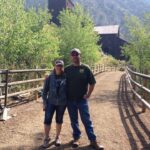 My niece, Kelli Schulenberg is a country girl, through and through. She loves living in the country and would love to raise donkeys. Unfortunately, right now, she and my nephew Barry Schulenberg don’t have any donkeys, but I think it would be cool if they got some. I know that every little kid in the family would love to ride a donkey or even just feed them. Donkeys can be so sweet. Of course, they can also be stubborn. They are a bit like kids that way, I guess. It’s just par for the course.
My niece, Kelli Schulenberg is a country girl, through and through. She loves living in the country and would love to raise donkeys. Unfortunately, right now, she and my nephew Barry Schulenberg don’t have any donkeys, but I think it would be cool if they got some. I know that every little kid in the family would love to ride a donkey or even just feed them. Donkeys can be so sweet. Of course, they can also be stubborn. They are a bit like kids that way, I guess. It’s just par for the course.
Kelli loves country music, and attends as many concerts as she can each year. That said, I guess you know that she has seen lots of country music stars in her lifetime. I’m not sure who her favorite star is and maybe that’s because she has so many favorites that no single singer exactly stands out…at least not to me anyway.
Kelli has two “men” in her life. My nephew Barry, who she married on January 31, 2004, and their dog, Scout…who she calls Sheriff Scout, because he is always on duty and ready to pounce. Of course, about the only thing Scout will ever need to “pounce” on would be a rabbit who is brave (of foolish) enough to get to close, or enter the yard, in general. Scout rules the roost, and Kelli will confirm that story for sure. Scout has tons of toys, and “needs” them all out at the same time…apparently. Scout is a source of joy and laughter to Kellie and Barry.
Kelli loves the outdoors and especially hiking and bicycling, which go hand in hand with the fact that she loves Summer the best. In fact, if it weren’t for cross country skiing and snowshoeing, Kelli would have absolutely no 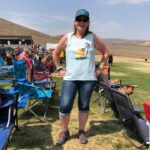
 use for Winter at all…and as to the wonderful Wyoming wind…well, she’s definitely not a fan…but they, how many of us really are. Kelli loves the mountains and camping, which is no fun in the winter either, Spring, Summer, and Fall, with a heavy emphasis on Summer is right up her alley. Kelli and Barry go camping as much as they can in the Summer. They especially love camping in the Big Horns, but they also like Colorado for camping places. Kelli is an outdoor girl who loves lots of fun outdoor activities, and all things country. Today is Kelli’s birthday. Happy birthday Kelli!! Have a great day!! We love you!!
use for Winter at all…and as to the wonderful Wyoming wind…well, she’s definitely not a fan…but they, how many of us really are. Kelli loves the mountains and camping, which is no fun in the winter either, Spring, Summer, and Fall, with a heavy emphasis on Summer is right up her alley. Kelli and Barry go camping as much as they can in the Summer. They especially love camping in the Big Horns, but they also like Colorado for camping places. Kelli is an outdoor girl who loves lots of fun outdoor activities, and all things country. Today is Kelli’s birthday. Happy birthday Kelli!! Have a great day!! We love you!!

